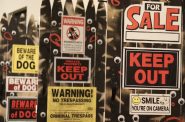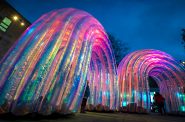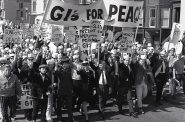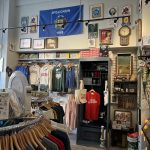Making a curatorial career out of chance
The newly hired Museum of Wisconsin Art director tells how chance opportunities, letterwriting and a Kleenex led her into a stellar curatorial life.
Laurie Winters was a driving force behind landmark exhibitions during her 15-year career as curator and director of exhibitions at the Milwaukee Art Museum, including Leonardo da Vinci and the Splendor of Poland, Beidermeier: The Invention of Simplicity, and Impressionism: Masterworks on Paper. She left MAM last fall but continues to have an impact on the area art scene in her new role: executive director of the Museum of Wisconsin Art in West Bend.
TCD’s Kat Murrell spoke with Winters to find out how she came to her career in the museum world, and what the future holds for the MWA as it prepares to move into a new building next month.
Kat Murrell: How and when did you decide to become to be a curator?
Laurie Winters: I really ended up being a curator just by accident. I was an assistant professor of art history at Rhode Island College in Providence. My husband was in New Haven at Yale Law School and we decided we wanted to move back to the Midwest where both of our families lived. We made the decision, and my husband was doing interviews with law firms all around the Midwest. We were both originally from Ohio but we thought we’d end up in Chicago. There are lot of law firms there, it’s a university and college-rich area, so it seemed like a good fit.
He was doing interviews in Chicago and just on a fluke, Quarles & Brady called him to interview in Milwaukee – he’d never been to Milwaukee, nor had I. He said, “Well, why not, I’ve never been there. I’ll just go do an interview,” and he ended up really liking it. He called me in Providence, Rhode Island, and said, “you’re not going to believe how nice Milwaukee is, I think I want to take the job here.” After a long pause on my end, I said, “Yeah, right.” The only thing I knew about Milwaukee was Laverne & Shirley. He convinced me to come out and take a look and I ended up liking it too.
I couldn’t imagine working in a museum, quite honestly, because I had a sense that museums were kind of boring places to work, so I was somewhat reluctant. But I came for an interview and he offered me the job at the first interview. I said, “I don’t know, I’ve got to think about it.” He said come back again, and I came back again and was really reluctant. I still didn’t know, and he said “Come back again, I want you to meet some people.” I came back a third time.

Francisco de Zurbarán (Spanish, 1598–1664). Saint Francis of Assisi in His Tomb, 1630/34. Image courtesy Milwaukee Art Museum.
There were two things that convinced me to take the job. First, he said, “Don’t worry about not knowing the job because you’ll learn it as you do it.” Then, as we were walking through the gallery and standing in front of the Francisco de Zurbarán, he picked up a crumpled Kleenex off the floor and put it in his pocket. He didn’t say a word, and then when we walked past a waste can he tossed it out. And I just thought, “Okay, that’s somebody who really cares. I could work for that person.” That’s how I decided.
I never imagined not being a university professor. It took some persuasion to convince me to do that, and then it took some persuasion to convince me to do this (become executive director of the Museum of Wisconsin Art). I’m so happy that I did because it’s great.
KM: What’s your favorite part of heading the Museum of Wisconsin Art so far?
LW: It’s a great staff, everybody is excited about the new building. But it’s not just a building, it’s about becoming another institution, going to the next level and figuring out how to deliver on that level.
It’s also a great community of patrons. We have a fantastic board. There’s a lot of passion and commitment around making it a great institution. People tend to think of it as an institution within a larger community within a larger state. It’s not just the four walls of the museum. I tend to think of it as a museum without walls. We have a breadth across the state through our website, and are figuring out how to connect with people across the state and around the world.
KM: Given your continuing leadership within The Art Consortium (a think tank devoted to issues and practices related to museums) and your role with the MWA, do you have certain strategies or plans you want to implement as far as exhibitions and programs?
LW: Having had a year of involvement with the Consortium has changed my thinking about museum operations. Some of the things we’ve been very concerned about are how people think about visual culture and what does that mean in terms of visual appreciation? What is the psychology of membership? Once you start thinking about those things in a larger context it changes how you think about the way the museum should function.

Artist’s rendering of the new Museum of Wisconsin Art building, scheduled to open in early April 2013. Image courtesy Museum of Wisconsin art.
KM: What are some exhibitions planned for the MWA this year?
LW: We’re opening with a contemporary glass exhibition called Antifragile. This is glass used in sculptural ways and as a medium that is, at least in theory, not fragile or meant to appear not fragile. I think it’s a really exciting exhibition and takes contemporary glass, and Wisconsin glass, in a new direction. We’re also opening with a small show by Reggie Baylor. Tom Bamberger is going to have a digital work on view.
In the fall we’re doing an exhibition of the photographs of Edward Curtis, and we’re also going to do an exhibition of Tom Jones, a Native American Wisconsin artist who teaches at UW-Madison. It’s a different take on the beginning of the 20th century versus the 21st century view of Native American identity.

Gustav Moeller, Unititled (Alma, WI), c. 1925. Oil on canvas. Image courtesy Museum of Wisconsin Art Collection.
KM: Do you have a favorite piece in the MWA collection?
LW: There are some beautiful landscapes from the Progressive era (late 19th-early 20th century) by Gustave Moeller that I think are just fantastic, they’re so fresh and exciting. I guess right now I would say Gustave Moeller is on my hit list of artists I’m really initially impressed with and think they’re kind of underrated.
And then, of course, I’m very fond of Tom Uttech. I think Tom is one of the great artists working in the 21st century. Truman Lowe is really interesting as well — he’s from Madison. I think he does intriguing work and has been for a while.
We’ve got the galleries laid out. We haven’t hung the works of art yet, but it’s really interesting to think about juxtapositions and relationships, so that’s what we’re doing right now.
The Museum of Wisconsin Art will celebrate its grand reopening on April 5-7, 2013, as it opens its doors in a new building at 205 Veterans Avenue in West Bend, Wisconsin.
<a href=”https://urbanmilwaukeedial.com/wp-content/uploads/2013/03/In-Tandem-Beast-on-the-Moon-Photo-4-of-5.jpg”><img class=”size-large wp-image-215674 ” title=”In Tandem Beast on the Moon – Photo 4 of 5″ alt=”” src=”https://urbanmilwaukeedial.com/wp-content/uploads/2013/03/In-Tandem-Beast-on-the-Moon-Photo-4-of-5-1024×681.jpg” width=”368″ height=”245″ /></a> Vincent, played as both his child self and an older narrator by Robert Spencer, is taken under Seta’s wing, as a replacement for children she is unable to bear.
Art
-
Winning Artists Works on Display
 May 30th, 2024 by Annie Raab
May 30th, 2024 by Annie Raab
-
5 Huge Rainbow Arcs Coming To Downtown
 Apr 29th, 2024 by Jeramey Jannene
Apr 29th, 2024 by Jeramey Jannene
-
Exhibit Tells Story of Vietnam War Resistors in the Military
 Mar 29th, 2024 by Bill Christofferson
Mar 29th, 2024 by Bill Christofferson



















